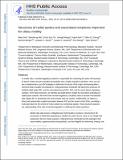| dc.contributor.author | Gui, Miao | |
| dc.contributor.author | Ma, Meisheng | |
| dc.contributor.author | Sze-Tu, Erica | |
| dc.contributor.author | Wang, Xiangli | |
| dc.contributor.author | Koh, Fujiet | |
| dc.contributor.author | Zhong, Ellen D | |
| dc.contributor.author | Berger, Bonnie | |
| dc.contributor.author | Davis, Joseph H | |
| dc.contributor.author | Dutcher, Susan K | |
| dc.contributor.author | Zhang, Rui | |
| dc.contributor.author | Brown, Alan | |
| dc.date.accessioned | 2021-10-27T19:52:37Z | |
| dc.date.available | 2021-10-27T19:52:37Z | |
| dc.date.issued | 2021 | |
| dc.identifier.uri | https://hdl.handle.net/1721.1/133399 | |
| dc.description.abstract | © 2020, The Author(s), under exclusive licence to Springer Nature America, Inc. In motile cilia, a mechanoregulatory network is responsible for converting the action of thousands of dynein motors bound to doublet microtubules into a single propulsive waveform. Here, we use two complementary cryo-EM strategies to determine structures of the major mechanoregulators that bind ciliary doublet microtubules in Chlamydomonas reinhardtii. We determine structures of isolated radial spoke RS1 and the microtubule-bound RS1, RS2 and the nexin−dynein regulatory complex (N-DRC). From these structures, we identify and build atomic models for 30 proteins, including 23 radial-spoke subunits. We reveal how mechanoregulatory complexes dock to doublet microtubules with regular 96-nm periodicity and communicate with one another. Additionally, we observe a direct and dynamically coupled association between RS2 and the dynein motor inner dynein arm subform c (IDAc), providing a molecular basis for the control of motor activity by mechanical signals. These structures advance our understanding of the role of mechanoregulation in defining the ciliary waveform. | |
| dc.language.iso | en | |
| dc.publisher | Springer Science and Business Media LLC | |
| dc.relation.isversionof | 10.1038/s41594-020-00530-0 | |
| dc.rights | Article is made available in accordance with the publisher's policy and may be subject to US copyright law. Please refer to the publisher's site for terms of use. | |
| dc.source | PMC | |
| dc.title | Structures of radial spokes and associated complexes important for ciliary motility | |
| dc.type | Article | |
| dc.contributor.department | Massachusetts Institute of Technology. Computational and Systems Biology Program | |
| dc.contributor.department | Massachusetts Institute of Technology. Computer Science and Artificial Intelligence Laboratory | |
| dc.contributor.department | Massachusetts Institute of Technology. Department of Mathematics | |
| dc.contributor.department | Massachusetts Institute of Technology. Department of Biology | |
| dc.relation.journal | Nature Structural and Molecular Biology | |
| dc.eprint.version | Author's final manuscript | |
| dc.type.uri | http://purl.org/eprint/type/JournalArticle | |
| eprint.status | http://purl.org/eprint/status/PeerReviewed | |
| dc.date.updated | 2021-07-15T18:08:08Z | |
| dspace.orderedauthors | Gui, M; Ma, M; Sze-Tu, E; Wang, X; Koh, F; Zhong, ED; Berger, B; Davis, JH; Dutcher, SK; Zhang, R; Brown, A | |
| dspace.date.submission | 2021-07-15T18:08:10Z | |
| mit.journal.volume | 28 | |
| mit.journal.issue | 1 | |
| mit.license | PUBLISHER_POLICY | |
| mit.metadata.status | Authority Work and Publication Information Needed | |
